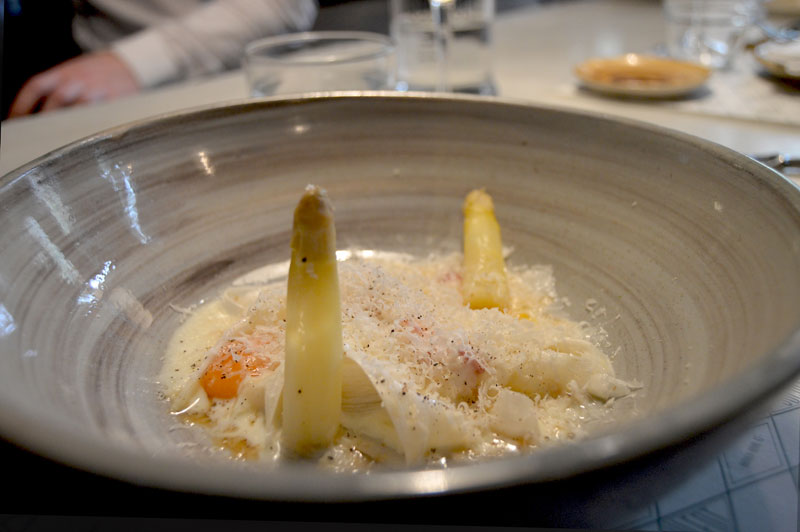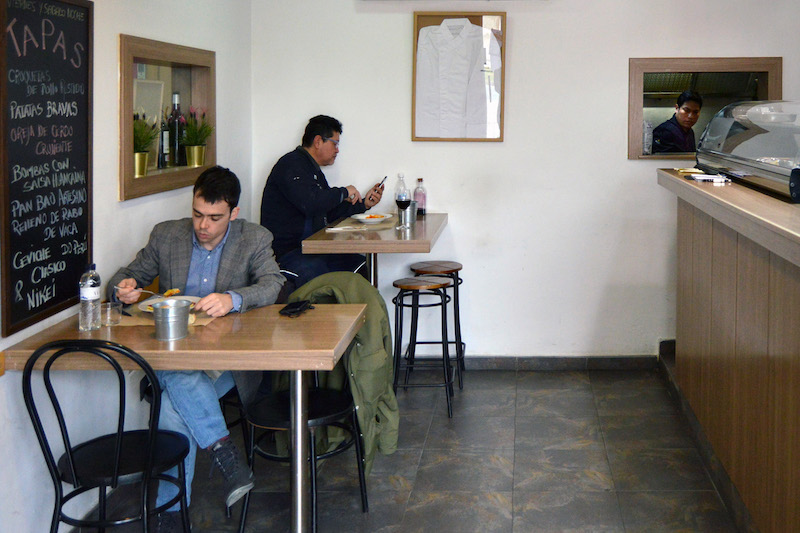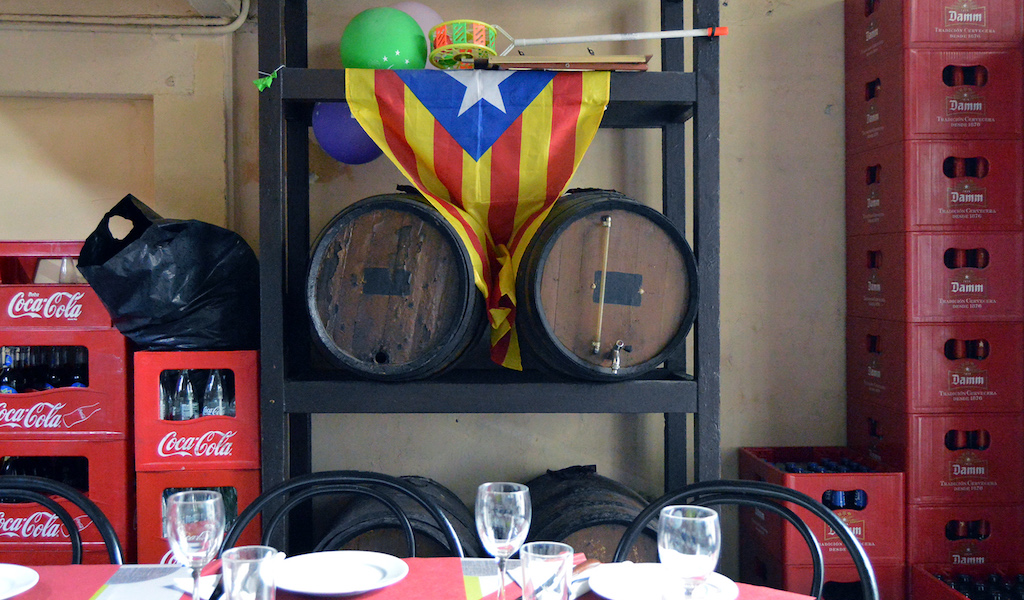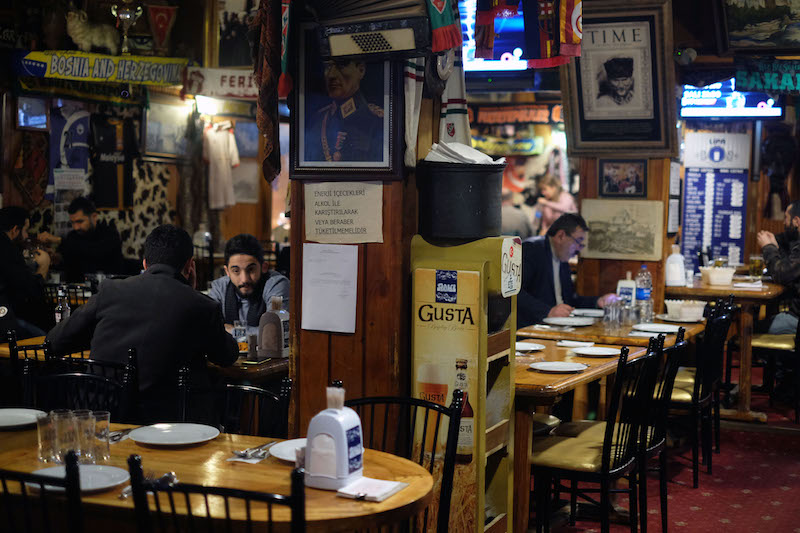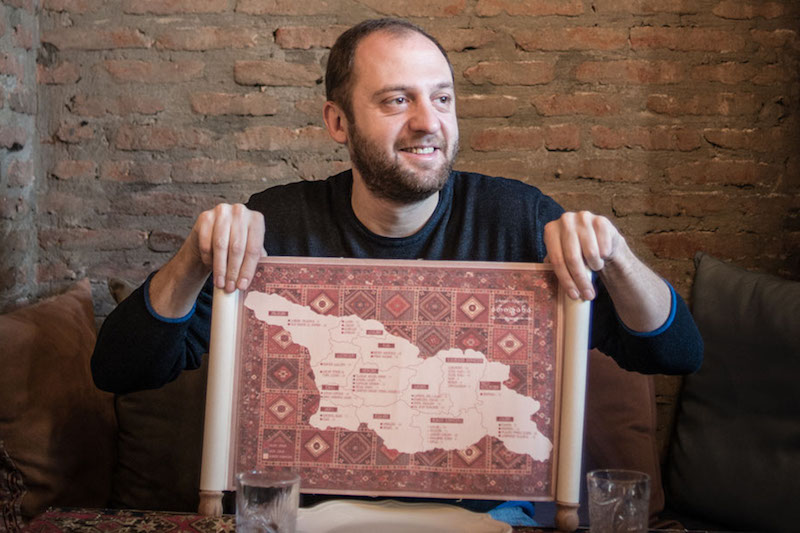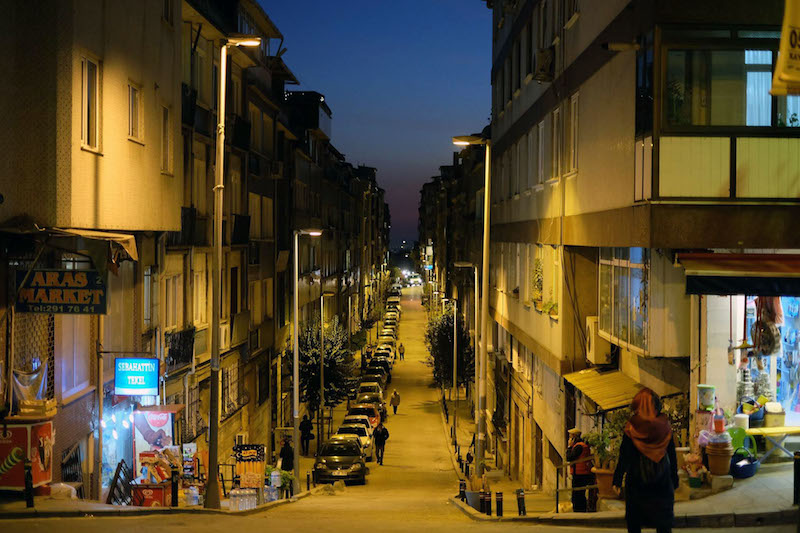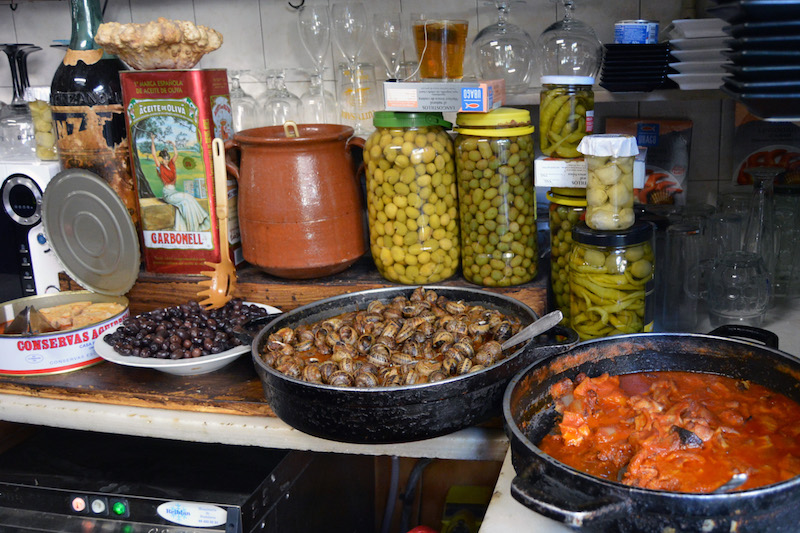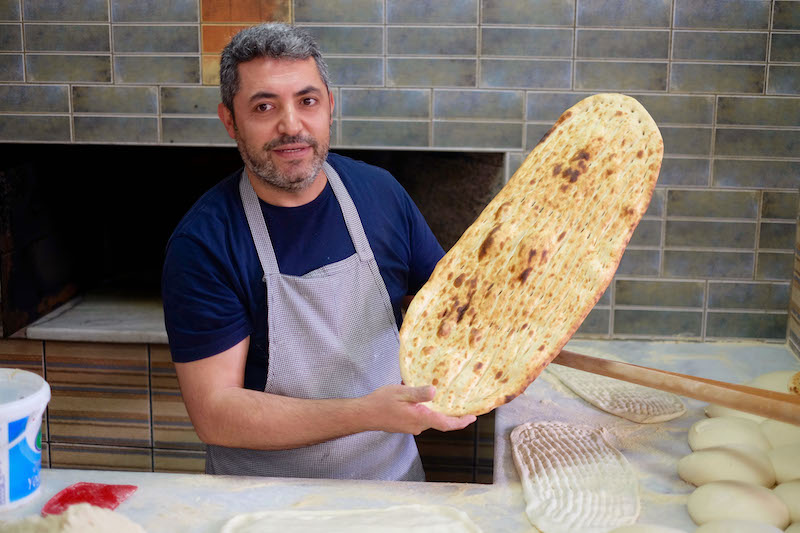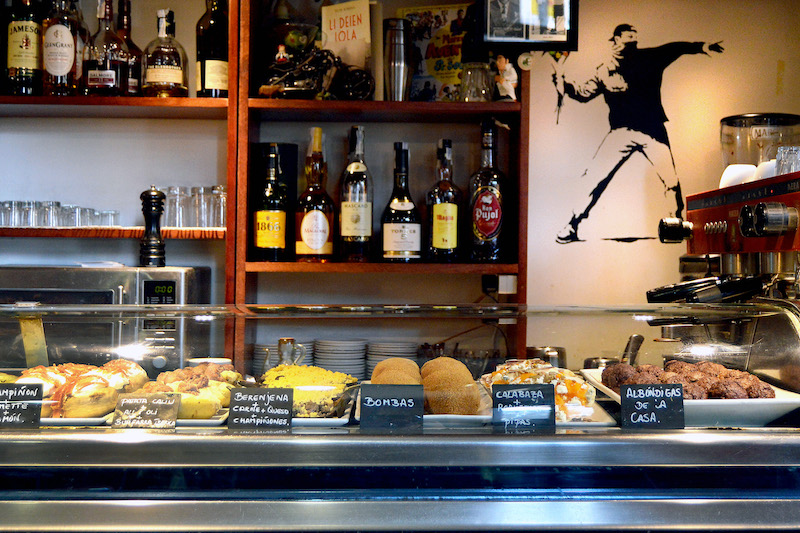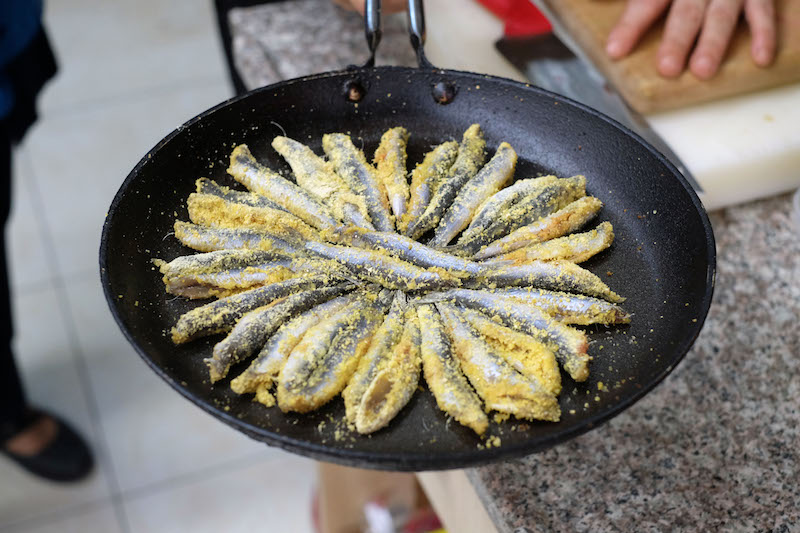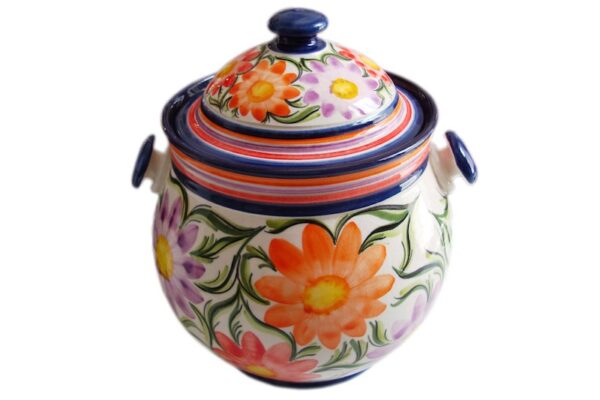We can't find the internet
Attempting to reconnect
Something went wrong!
Hang in there while we get back on track
Search results for word=paul+r
Barcelona
Drinks With a Side of History: Barcelona’s Top 5 Bodegas
The easiest way to pick out a bodega in Barcelona is to look for big wooden wine barrels – they always, and we mean always, feature prominently in these taverns. Locals frequent their neighborhood bodega for myriad reasons: some come to buy affordable bulk wine from the barrels to take home, others to have a vermut (vermouth) with anchovies, or other drinks and tapas, for an aperitif. Sometimes, in those special cases where the bodega evolved to include a kitchen, they also come to enjoy a magnificent meal. These living monuments were, and still are, witnesses to Barcelona’s history, from the Spanish Civil War to the gentrification and intense “touristification” currently taking place in the city. If the walls of Barcelona’s bodegas could talk, we would eagerly listen to the stories of neighborhood life in Barcelona over the last century
Read moreBarcelona
Cal Siscu: Seafood Takes the Crown
Despite the big wooden casks on the wall and the creaky shelves crowded with bottles behind the bar, wine is no longer king at Cal Siscu, an old bodega (wine store and tavern) in Hospitalet de Llobregat, a city located on the periphery of the Barcelona metropolitan area. The new ruler, who has deigned to keep these old relics from an earlier era, is seafood – every day the bar’s counter is covered with trays of majestic treasures from the Mediterranean and the Atlantic like prawns, clams, barnacles and sea snails. Founded by Francisco “Siscu” Rosés in 1933, Cal Siscu originally sold bulk wine and liquors. At that time, the only seafood served came from a can. Customers frequented the tavern, which also doubled as a home (Siscu and his family used to live upstairs), to fill up their wine jugs and sip on a vermut with some olives and conservas like tuna or sardines.
Read moreIstanbul
Spring Surprises: Skewering the First Fruits in Istanbul
It was the first of April and an absolutely pristine Istanbul spring day, the kind where one can break a slight sweat walking up a hill then catch a cool breeze in a nearby patch of shade. Returning to the city from a lovely weekend on Büyükada, we were smitten with spring and wanted to indulge in its finest offerings. In a fit of hunger-fueled inspiration, we quickly realized what we were craving: yenidünya kebabı. This spring-only affair is a specialty from southeast Turkey’s Gaziantep where chunks of minced beef and/or lamb are skewered in between sections of newly arisen yenidünya, or loquat, diminutive orange fruits that are as tantalizingly tart as they are sweet.
Read moreBarcelona
Spring Surprises: Edible Flower Season in Barcelona
Flowers may be a visual treat, but they are also a regular ingredient in the cooking of numerous cultures. It’s not uncommon to find roses, violets, orchids, chrysanthemums or any number of flowers – more than 200 in the world are catalogued as edible – adding a pop of color or a surprising flavor to a dish. Flowers have particularly deep roots in Spanish cuisine. They featured most prominently in the food of Al-Andalus, the territory of southern Spain governed by Muslims during the medieval period. Influenced by the Arabs, Andalusian cooks used rose and azahar (orange blossom) to aromatize water and make syrups, jams and pastries.
Read moreTbilisi
Spring Surprises: Wild Greens in Tbilisi
Out here in Garikula, our slice of heaven an hour west of Tbilisi, spring is peaking. It started with the plum blossoms and now the apple, pear and cherry blossoms are popping, painting the countryside in patches of white and pink. Walking along a village path with our neighbor Shota, he suddenly stops, bends down and reaches into a wad of weeds and pulls. “Ah-ha,” he says showing us a little bundle of wild asparagus, skinny, green and an appetizing revelation when cooked just right. Back in Tbilisi, this asparagus appeared in the central bazaar a couple weeks ago, along with other welcomed indications that springtime has finally arrived.
Read moreIstanbul
Farewell, Pando: An Istanbul Culinary Legend Passes On
It’s Saturday around lunchtime and business as usual in the bustling Beşiktaş Çarşı neighborhood, as crowds of mostly younger people fill the narrow streets. Down on Mumcu Bakkal Sokak, a pedestrian-only street lined with miniscule shops, a line around the block has been formed by those eager to get into one of the city’s best döner spots. For many of those waiting in line, however, it’s impossible to ignore the scaffolding-covered building just across the way. Though the scaffolding masks most of the historic building, it’s still possible to make out strips of the distinctive baby blue color of what was one of Istanbul’s most beloved eateries: Pando’s kaymak shop.
Read moreIstanbul
Bağdat Ocakbaşı: Licensed to Grill
Istanbul’s T1 tramway is relatively pleasant if you can find a seat, but borders on unbearable if you are on your feet. Back in 2015, we wrote about a trip we took from the line’s first stop all the way to one of its last, which lies way out in the district of Güngören. By the time the tram has made it to this point, it begins to perplexingly share a lane with traffic, voiding the whole point of this type of public transportation. On one weekday evening, we found ourselves standing in a rather contorted position on the beyond-crammed train, a price we were willing to pay for a trip to one of our favorite culinary hotspots. The journey took over an hour. It was well worth it.
Read moreBarcelona
Spring Fever: The Greening of the City
Barcelona’s urban sprawl makes it easy to forget that the city is adjacent to two fertile regions to the north and south, El Maresme and El Baix Llobregat, which provide numerous hyperlocal culinary treasures throughout the year. In spring as in other seasons, these treasures appear at markets and restaurants, their origins proudly displayed, sometimes even with the names of the specific villages that they come from. The coast and gently sloping mountains of El Maresme are home to numerous villages, three natural parks and beaches. Unsurprisingly, there’s an abundance of seafood here, including gamba de Arenys (Arenys prawns), scampi (escamarlans in Catalan, cigalas in Spanish) and little Mediterranean sand eels (sonsos in Catalan).
Read moreIstanbul
Dose & Istos Café: Greek Revival
A café at its best is so much more than the sum of its parts: it’s a place where people can easily mingle, share ideas, and dertleşmek, or commiserate over their troubles, all while imbibing caffeine. At the same time, it’s a place where visitors might feel an invisible thread of common beliefs connecting them, an unspoken camaraderie, even if they don’t socialize with anyone. This community spirit runs strong in Dose & Istos Café, a new Rum (pronounced “room,” the name given to Turks of Greek descent) café in the heart of Beyoğlu. When we first went one rainy Sunday evening on a tip from a friend, we didn’t remember the exact address, just general directions that it was off Istiklal Street, near Galatasaray Lycée.
Read moreBarcelona
Agreste de Fabio & Roser: Good Weed
Up in Barcelona’s hills, in the El Coll neighborhood, where the city ends and the sky is cut by the spiky shapes of the pine trees in Collserola Park, Agreste de Fabio & Roser is sprouting up. Emphasizing sustainability and healthy eating, the restaurant is creating delicious dishes that merge Catalan and Italian traditions with contemporary flourishes. Room manager Roser Asensi and her partner, chef Fabio Gambirasi, created this project (the name means “bad weed” in Spanish) less than a year ago and people are already singing their praises. On a recent visit, we could hear words of admiration from different guests flying around the room over the course of our meal.
Read moreTbilisi
Dukani Racha: Tbilisi’s Oldest Greasy Spoon
We returned to Tbilisi in 2002 with the intention of staying one year. On that first day back, our friends took us to a chummy brick-walled cellar in Sololaki. There was enough sunlight coming down through the door to illume low pine tables and seating for fifty people max. In a refrigerated counter, menu items were displayed: beef tongue, tomato and cucumber salad, assorted cheeses, badrijani (sliced fried eggplant stuffed with a garlicky walnut paste), all the standard stuff. It was a Georgian greasy spoon, for sure, with a kitchen that would make a health inspector shudder, but the khinkali were really good, and the house wine was as decent as it comes. The name of the place was Dukani Racha. Little did we know people had been coming here for decades.
Read moreLisbon
A Time Out for Lisbon’s Market Makeovers?
“It’s good for tourists, not for us.” While this can sadly be said about many things, Anabela, the woman we are speaking to, is referring to the transformation of Mercado da Ribeira, Lisbon’s historic public market, where she co-runs a small grocery store. Originally built as a predominantly wholesale food, fish and flower market in 1771, Ribeira today shares its space with Mercado Time Out, financed by the venture capital firm that controls the publishing franchise in Portugal, which has occupied the central section of the market since 2014. Time Out’s concept: an “editorially” curated gourmet food hall. Selling the best of Portugal – from croquettes and custard tarts to seafood and steak – it is now a top attraction, with 24 restaurants, eight bars, a dozen shops and a high-end music venue.
Read moreBarcelona
El Practic: The Itinerant Gourmet
El Practic doesn’t look like much at first glance. The small restaurant is sparsely decorated and populated by a few naked tables. Its location – in front of two massive buildings under construction in Cornellá de Llobregat, an industry-heavy municipality on the southwestern periphery of the Barcelona metropolitan area – is not where many people would choose to set up a restaurant. But chef Andrés Huarcaya was certain people would come. “I’ve worked in so many places,” he said, “and one day it hit me that if you do good work – this is the key – then people will come. On this street, nobody passes by at night. And yet we are always packed on Fridays and Saturdays – totally packed!”
Read moreIstanbul
Market Watch: Semt Pazarları, Civic Life Perfected
“Two kilos five liraaa! Two kilos five liraaa!” bellowed a young and exuberant vendor of tomatoes to the ongoing stream of frugal-minded shoppers making their way through the snaking Tarlabaşı Sunday Market. Hundreds of sellers of fresh produce, dairy, seafood, kitchenware, clothing, smuggled tobacco, jewelry, fresh baked goods and numerous other items set up side by side in the central Istanbul quarter of Tarlabaşı every Sunday, weaving an extended path down a backstreet that incorporates both unbridled chaos and strict organization. It is just one of hundreds of similar weekly semt pazarları, the beloved Istanbul neighborhood bazaars that offer some of the cheapest prices on the widest variety of goods the city has to offer, while at the same time serving as a critical element in maintaining the vitality of Istanbul neighborhood life.
Read moreBarcelona
Pirineu en Boca: Straight From the Mountains
There are many legends and myths surrounding the Pyrenees. Some claim that the divine hero Hercules created the mountains by piling up rocks as a tomb for his love Pyrene, who had died in one of the area’s forests after being bitten by a snake. While a romantic story, the Pyrenees are much more than a mausoleum and a symbol of mythic love – they are also the birthplace of Basque culture and a disputed border between Spain and France, a place crisscrossed by Roman roads and sprinkled with Roman architecture, a key point in the Camino de Santiago (Way of Saint James) and a legendary land for the Catalans.
Read moreBarcelona
Cava: A Toast to Spain's All-Day Sparkler
Cava, the Spanish sparkling wine, is an indispensable part of celebrations in Barcelona – though we’re happy to find other reasons to raise a glass of the stuff any day of the week (particularly on a dreary Monday). It’s produced using the same méthode traditionnelle that is used for French champagne: after the base wine is fermented from the pressing, it’s bottled, usually with a mixture of sugar and yeast, to undergo a second fermentation to produce that ebullient fizz.
Read moreBarcelona
L’Artesana: Workers’ Delight
Years ago, when it was a booming industrial center, Poblenou saw thousands of workers stream in every day to toil away at one of several factories in the neighborhood. Hearty fare was required to keep them going – sure, taste mattered, but sustenance was the most pressing concern. Poblenou may no longer be filled with factories, but there are still plenty of people who spend their weekdays in the area, working at one of the many start-ups, tech companies or communications firms that have set up shop in their place. When it comes to lunch, these 21st-century workers want the same thing that those who came before them did: lunches that fill their stomachs and satisfy their taste buds without leaving a big hole in their pockets.
Read moreTbilisi
Something Brewing: Georgia’s Tea Renaissance
“Tea,” our friend Lasha indicated with a head nod, driving past fields with rows and rows of overgrown, chest-high, bushes of green leaves. It was 2002 and we were zipping along a skinny road littered with potholes on the outskirts of Zugdidi in west Georgia, but we could have also been in Guria or Adjara or even Imereti; regions with tea fields that have also become agrarian relics. Later we visited the last operating tea factory in town, a Soviet era rust bucket of a building that Lasha said churned out leaf dust that was sold to Lipton. Such was the fate of an industry that had once provided the USSR with 95 percent of its tea. However, after decades of inaction, Georgian tea production is slowly making a comeback.
Read moreBarcelona
Barcelona: State of the Stomach
In 1977, just two years after the death of Franco, the great Catalan gourmet Manuel Vázquez Montalbán published a book titled L’art de manjar en Catalunya (The Art of Eating in Catalonia). The book, as well as the prologue written by Montalbán’s mentor Néstor Luján, rang the alarm bells, claiming that authentic Catalan cuisine was in grave danger and on the brink of disappearance. As Montalbán saw it, the unique Catalan culinary identity has been reduced to a few ubiquitous dishes: pan a la Catalan (bread with tomato pulp and ham) and rabbit with aioli. This demise was due, in his opinion, to the frenzied pace of modern life, the lack of high-quality ingredients, the ignorance of both restaurateurs and tourists regarding what good cuisine, not to mention true Catalan cooking, looks and tastes like and, of course, the Franco regime’s efforts at suppressing regional identities.
Read moreBarcelona
Espai Mescladís: Barcelona, Open City
The entryway of Espai Mescladís is jam-packed with people: neighbors, workers and visitors who come and go all day long, and waiters walking from the kitchen to the tables on the terrace. But there are also dozens of people staring out from black and white photos that cover the restaurant’s walls; some are alone, others in couples, families or groups, smiling and laughing. All the people pictured at one point emigrated to Barcelona, and whether they’re still living in the city or have moved elsewhere, their stories are always present at Espai Mescladís. The photos, taken by the photographer Joan Tomás, were originally part of an exhibition organized by the Mescladís Foundation, a multifaceted initiative that provides tangible and sustainable economic programs, particularly in the form of job training, for migrants and refugees in the city.
Read moreIstanbul
Istanbul: State of the Stomach 2018
Groaning sounds emanated from the other end of the line when we told a friend the location of our dining plans for the night. The spot, a rowdy, charming dive specializing in Bosnian-style mezes and grilled meats, was in Pendik, a district of Istanbul well over 20 kilometers outside the center, on the outskirts of the Anatolian side. Our friends’ reluctance to join was a normal response in a city with terrible traffic and nightmarish commutes. Who would want to spend their free time on a three-hour roundtrip journey to eat out when there are plenty of excellent options just a stone’s throw away?
Read moreTbilisi
Tbilisi: State of the Stomach 2018
A few months ago a little storefront joint opened down the street next to our neighborhood green grocer, a mom and pop operation that has been there for decades. A varnished wooden counter behind the iron-framed windows and a few matching tables make it fit the new bohemian-chic Tbilisi style popping up the street around Rooms Hotel, the hip four-star flophouse all the travel magazines are fawning over these days. Although the wine list was not well-stocked, the food didn’t disappoint. The pork belly was not the standard room-temperature slab of bacon on a plate, but was oven-roasted and nestled on two puddles of cherry and plum sauce, zesty richness that nearly overpowered the smokiness of the pork. It was simple, bold and delicious. And it was Georgian, although not everyone will agree on that.
Read moreTbilisi
Tbilisi: State of the Stomach
A few months ago a little storefront joint opened down the street next to our neighborhood green grocer, a mom and pop operation that has been there for decades. A varnished wooden counter behind the iron-framed windows and a few matching tables make it fit the new bohemian-chic Tbilisi style popping up the street around Rooms Hotel, the hip four-star flophouse all the travel magazines are fawning over these days. Although the wine list was not well-stocked, the food didn’t disappoint. The pork belly was not the standard room-temperature slab of bacon on a plate, but was oven-roasted and nestled on two puddles of cherry and plum sauce, zesty richness that nearly overpowered the smokiness of the pork. It was simple, bold and delicious. And it was Georgian, although not everyone will agree on that.
Read moreTbilisi
Shavi Lomi: The Black Lion for Golden Guests
In the Caucasus, guests are considered gifts from God. Georgians like to call them okros stumrebi – “golden guests” – an endearment that illustrates the stature the ever-hospitable Georgians give to those they host. And whenever our own golden guests come to visit in this remote corner of the world, we never fail to entertain them in our own surrogate dining room, Shavi Lomi (the Black Lion). The cellar restaurant is an homage to Georgia’s favorite artist, Niko Pirosmani, a naive painter whose favorite subjects were animals, a singer named Margarita and feast scenes. The flea-market furniture, tablecloths and china make the Black Lion an ideal setting for anybody hankering to create a one-of-a-kind, laid-back feast scene of his own, with hearty original takes on traditional Georgian cooking.
Read moreIstanbul
Yıldırım Usta’s Kebab: Tailgate Party
Kurtuluş Son Durak is a busy intersection and transit hub that’s a hive of activity 24 hours a day. Marking a transition between the tidy, middle-class Kurtuluş neighborhood and the rough-and-tumble quarters of Dolapdere and Hacıahmet, the area is home to a host of eateries and cafes that never seem to close. Right in the center of it all, we stumbled across a diminutive white van rigged with a makeshift grill. Inside the tiny, elaborately decorated vehicle crouched Yıldırım Usta, a 75-year-old veteran of the kebab trade who has been serving up truly delicious dürüm – kebab wrapped up in flatbread – on Kurtuluş Son Durak for 28 years. He has lived in the area for just under half a century. “You see all these other kebab shops? I was here before all of them,” he told us.
Read moreWorldwide
Going Deep: Neighborhoods to Visit in 2018
As the calendar year turns over, we’ve grown accustomed to the barrage of lists telling us where to travel during the next 12 months. Oftentimes these places are a country or even a whole region – you could spend an entire year exploring just one of the locations listed and still barely make a dent. We like to travel on a smaller scale. Forget countries and cities, for us the neighborhood is the ideal unit of exploration. Celebrating neighborhood life and businesses is, of course, essential to what we do as Culinary Backstreets. Since our founding in 2012, we’ve been dedicated to publishing the stories of unsung local culinary heroes and visiting them on our food walks, particularly in neighborhoods that are off the beaten path.
Read moreTbilisi
Sunflower Health Food Store: Organic Change
The year was 2001, and we were squeezed around an enormous table, together with a half dozen men in their late fifties, in a small conference room at a Soviet-era tobacco collective in Lagodekhi, near the Azerbaijan border. The director of the collective casually slipped a biography of Joseph Stalin under the table and told us the story of the farm, although we weren’t really interested. Our local host had hijacked us into the meeting, believing we could give these gentlemen sound business advice simply because we were westerners. “Our tobacco is natural, no chemicals,” the director asserted. “Yes,” another man interjected with a grin, “we have no money for chemicals.” The men all chuckled.
Read moreBarcelona
Best Bites 2017: Barcelona
This was an intense year for Barcelona, with a complex political situation stemming from Catalonia’s bid for independence from Spain. It was a storm that the culinary scene could not help but get caught up in. Bars and restaurants have always been a temple of leisure and pleasure, but we sometimes forget that they also serve as a space for people to connect and debate. And in the spirit of debate, food and drink constitute another form of expression, an indication of a restaurant’s cultural leanings. In Barcelona this year, we could taste the continued interest in developing and strengthening Catalan cuisine, often considered an extension of Catalan identity. But we also observed the food scene’s openness to other regional cultures and global influences.
Read moreIstanbul
Best Bites 2017: Istanbul
After an awful 2016 punctuated by bomb attacks and a failed coup attempt, Istanbulites were clinging to the desperate hope that tensions would ease in the new year. Then, shortly after bottles had been popped and toasts had been made, news suddenly poured in that the city’s ritziest nightclub had been sprayed with bullets in a shocking and tragic attack that claimed the lives of 39 people. Though the year started off with the kind of bang I wasn’t expecting, things have calmed down in 2017. This has afforded Istanbulites the opportunity to spend less time worried about their own personal safety and more time focused on the still-troubling political situation that clouds Turkey today.
Read moreTbilisi
Best Bites 2017: Tbilisi
Editor’s note: We’re celebrating another year of excellent backstreets eating by taking a look back at our favorite restaurants and dishes of 2017. Starting things off is a dispatch from our Tbilisi bureau chief Paul Rimple: In 2001, a chic fashion designer opened up a snazzy café in the Vake Park building we were living. The low quadratic furnishings were not made for comfort, but were perfect for posing with your nose in the air and a cigarette between your fingers. It was the only cafe in this part of town and lucky us, it was downstairs.
Read moreBarcelona
Bodega Bartolí: Built on Soup
Bodega Bartolí opened in 1939 as a little bulk wine shop in Barcelona’s Sants neighborhood. Then everything changed for the bodega some 20 years later when a local client arrived with a stomachache. He asked a young Marina Dolz, who was minding the wine shop with her husband, if she could prepare some soup for him. It was the first dish she cooked there and, since then, Bodega Bartolí has moved far beyond simply being a wine store. At the time Bodega Bartolí opened, Sants was still an industrial quarter with several factories and thousands of workers. During the 1940s, the bodega sold both bulk wine to the neighbors and factory employees and barreja (a very traditional drink made of Muscat wine and anise liquor) to the wheelwrights passed by everyday.
Read moreIstanbul
Kulu Büryan & Kebab Salonu: Underground Favorite
It was 10 a.m. on a bright, crisp Monday morning as we blasted down a miraculously traffic-free stretch of Istanbul’s E-5 highway. We were en route to Bağcılar, a jam-packed outer district home to three quarters of a million people. Awaiting us was an ambitious breakfast of büryan kebabı, delectable lamb meat roasted to perfection in a belowground coal-fired oak tandoor oven before emerging in all of its glory, ready to be sliced and devoured quickly with fresh flatbread. Clearing a vast swath of the notoriously traffic-strangled city in less than 20 minutes, the first meal of the day was just around the corner and we already had the feeling, mere hours in, that this was going to be a good week.
Read moreBarcelona
Bar Ramón: Beats & Eats
It’s not too often that you find a restaurant in Barcelona where rock & roll, blues and jazz are some of the main ingredients. But that’s just the case at Bar Ramón, an iconic restaurant and tapas bar in Sant Antoni. Mediterranean grilled red prawns, patatas bravas, and xipirones (baby squids) a la Andaluza (coated in batter and fried) are carried from the kitchen to the table under the watchful eyes of Charlie Parker and Muddy Waters, who look down from posters on the wall. Also on the wall, sharing space with the standard FC Barcelona crest and a photo of a castell (Catalan human tower) in front of the old Sant Antoni Market, is Bo Diddley’s guitar.
Read moreIstanbul
Emice’nin Yeri: Black Sea Soul Food
Everyone seems to feel at ease in Emice’nin Yeri. It’s the kind of place where workers come after their shifts, families and couples dine, single men drink their tea and watch football matches on the TV, and women too are comfortable eating alone. It’s not just a welcoming place – Emice’nin Yeri also happens to be one of the best Black Sea restaurants around. The emice part of the name comes from the Laz language and means “uncle,” or amca in Turkish, so can be translated to “Uncle’s Place,” a fitting moniker for the restaurant does have a certain avuncular charm.
Read moreElsewhere
The CB Gift Guide 2017
Truth be told, we’re often not impressed with traditional holiday gift guides. They’re either littered with undisclosed affiliate links or seemingly endless lists (much like our holiday to-dos) that make us want to turn off the computer and hibernate until the end of January. So, what makes our gift guide different? It’s a highly-selective (and relatively short) list of products that our correspondents and guides eat and use. Many of them are featured in stories that we’ve published, and we worked our hardest to connect you directly with producers – while we weren’t always successful, we did manage to avoid Amazon entirely (and no affiliate links in sight).
Read moreLisbon
CB Book Club: Barbara Massaad’s “Soup for Syria”
Barbara Abdeni Massaad may be an award-winning food writer and photographer, but she is also a humanitarian. After spending quite some time with the Syrian refugees who were living in horrible conditions not far from her home in Beirut, Barbara took her camera and began photographing people in the camps in Lebanon, especially children. This was the start of her book-cum-fundraising project “Soup for Syria: Recipes to Celebrate Our Shared Humanity,” a wonderful collection of pictures and soup recipes that has already raised $500,000. The profits from book sales are donated to help fund food relief efforts through the United Nations.
Read moreIstanbul
CB on the Road: Mersin’s Tantuni Trifecta
We boarded a train in Turkey’s kebab capital of Adana and headed an hour west to the calm, palm tree-lined coastal city of Mersin with one thing on our minds: tantuni. While available at a number of recommendable establishments in Istanbul and other Turkish cities, tantuni in Mersin exists on a different plane of existence, with its prized status as the city’s flagship food. Tantuni is frequently billed as the Turkish equivalent of a taco, and while this comparison is not altogether unwarranted, we think it is primarily invoked by those with a particularly fierce longing for Mexican food. We believe tantuni should be evaluated on its own merits, which stand proud and tall.
Read moreBarcelona
Bodega Neus: First Came the Wine, Then Came the Seafood
Bodega Neus, a tranquil, cozy spot on a narrow street in Gràcia, may look like a regular old bodega-restaurant. But this place, which is celebrating its centennial in 2017, merges two culinary traditions with deep roots in Barcelona: wine and seafood. In the beginning, Bodega Neus was a bulk wine-shop. Over the decades, it morphed into a bar and then a restaurant; during the course of it’s 100-year history, it was owned only by two families, both of which respected the spirit of the bodega and the traditional recipes that anchored the menu.
Read moreTbilisi
Tbilisoba: Harvest Bacchanalia for the Whole Family
When it comes to fragrances, nothing makes you stop in your tracks and moan in delight more than the redolence of mtsvadi roasting on the coals of grape vine trimmings. It’s the juicy sizzling fat basting the chunks of skewered pork that clinches it and makes whiffing the browning meat just as good as eating it. For one October weekend every year, the entire center of Tbilisi is immersed in wafts of barbecue from perhaps hundreds of hot grills, called makhali, as men, teary-eyed in billows of smoke, turn the skewers in pop-up sidewalk picnic parties. This is part of an annual event called Tbilisoba, a kind of Georgian Oktoberfest, but much cooler.
Read moreIstanbul
Falling for The City: An Ideal Autumn Day in Istanbul
Fall often crashes down like a ton of bricks over Istanbul, but it’s a welcome blow. Crisp evenings replace sticky, humid ones overnight. During the day it’s warm enough to walk around in a T-shirt if it’s sunny, though you may need to have a sweater on hand if the sun dips behind a cloud. It was a late afternoon in early October that cemented our deep love for Istanbul. We boarded a ferry from the Anatolian side before the sun set. It was still warm enough to sit outside without a jacket, and the energy of the changing season, both invigorating and soothing, coursed through the air and then our veins.
Read moreTbilisi
Harvest Week: Bluesy Kakhetian Wine
The Telavi-Gurjaani Highway is a two-lane ribbon that meanders across the fertile Alazani Valley, linking sedate east Georgian hamlets together like a string of old lights. Not a lot happens out here; SUVs and new sedans speed past lethargic jalopies and donkeys pulling carts of sticks, while men sit under the shade of the trees watching the world go by. The vibe changes in September, though, when the slumbering villages spark to life. It’s harvest time, and the rural road is suddenly busy with cars, dump trucks and tractors pulling trailers – all either packed with grapes or one their way to the fields to pick them. This is Georgia’s largest wine region and nearly every family here has some stake in the winemaking process.
Read moreBarcelona
Barcelona Post-Referendum: Difficult to Digest
I used to joke that the only thing binding together Spain is the classic tortilla española, which in Catalonia we refer to as the tortilla de patatas – a neutral name. This potato omelet is one of the very few traditional dishes that is prepared the same way (and equally beloved) throughout Spain’s Autonomous Communities, the regions created after the Spanish Constitution of 1978, a necessary step towards creating a democratic country after the end of Franco’s dictatorship. The fact that this is one of the few dishes we all have in common highlights the significant regional differences of our traditional cuisine, despite our common Mediterranean culinary culture.
Read moreBarcelona
Bubbling Over: Barcelona Braces for the Catalan Independence Referendum
Bar chats are on fire these days in Barcelona. As the controversial Catalan independence referendum draws closer, it’s not uncommon to witness spontaneous private discussions or overhear customers express passionate or indignant comments while reading the newspaper or watching the news on the bar’s TV. There is tension in the air, and bars, perennially popular agoras for debate, have become even livelier places. Many Catalans, whether pro-independence or not, will find themselves voting under difficult conditions on Sunday, October 1, in the controversial referendum organized by the Catalan government.
Read moreIstanbul
CB on the Road: Antakya’s Under-The-Radar Food Scene
Turkey’s charming southern city of Antakya lies equidistant to the Mediterranean coast and the Syrian border, in the province of Hatay. The area is famed for its unique, spice-laden cuisine, though it is perhaps overshadowed by that of its neighbors to the east and west: Adana and Gaziantep, respectively. The former is practically synonymous with kebab while the latter is famous for, well, everything, and is often touted as Turkey’s undisputed food capital. But a recent two-day trip to Antakya made it imminently clear that its cuisine deserves just as much praise as Adana’s glorious grilled skewers and Gaziantep’s divine baklava. The integrity and autonomy of its rich cuisine comes as no surprise to anyone acquainted with this special city.
Read moreLisbon
Night Pickers: Harvesting Grapes in Dão
Although it’s the oldest wine region in Portugal, Dão in central Portugal does not have the high profile of its neighbor to the north, the Douro Valley. And yet, Dão is the birthplace of the touriga nacional, one of the finest grapes in Portugal, a country with more than 300 different grape varieties. Considering this claim to fame, we thought the overlooked Dão region deserved a second glance. If we had any doubts about making the trek out to Dão, they were put to bed by André Ribeirinho. A Portuguese writer and wine judge, Ribeirinho knows the best small-scale Portuguese wine producers and champions them on his website Adegga, a platform he founded to review wines and host wine markets.
Read moreTbilisi
Feasting in Garikula: Summer Days and Nights in a Sleepy Georgian Village
The table was a motif of fresh delights we had never seen before, all the ingredients from the family garden. In due time we would learn about pkhali, chicken tsatsivi and the intrepid Georgian ratatouille, ajapsandali; however, the only thing on our minds was surviving the barrage of toasts our host Aleko was pummeling us with. In Georgia guests are considered gifts from God, though it was clear from the beginning that the god Aleko had in mind was Bacchus. If we failed to drain the water glass full of his wine to the bottom, he would refill it and force us to do the toast right a second time.
Read moreRio
Contemporâneo Lapa: Bar Snacks from Afar
Lapa is the heart of bohemian Rio de Janeiro, a place that pulses with samba music and the clamor of bargoers. Local musicians, artists and intellectuals (and tourists, too) flock to this old neighborhood, which during the day is best known for its rich stock of colonial-era architecture and where at night more than 200 bars fight for customers. Almost all the bars offer the same thing: live samba music, cheap beer and bad food. But Contemporâneo Lapa is bucking this trend. The bar is situated on one of the most frenzied blocks in Lapa – it’s brimming with prostitutes and drug dealers (the neighborhood hasn’t completely shed its dubious reputation) as well as tourists and Cariocas chasing a wild night out.
Read more






